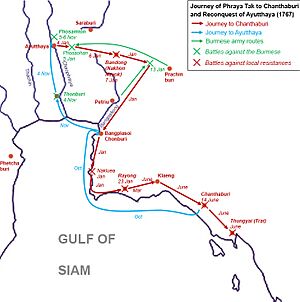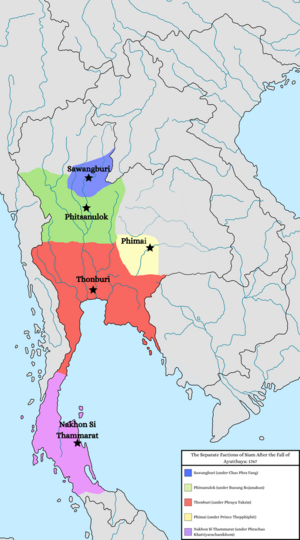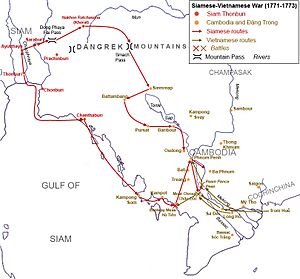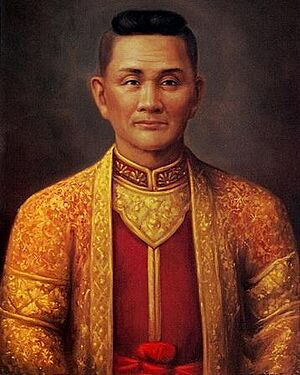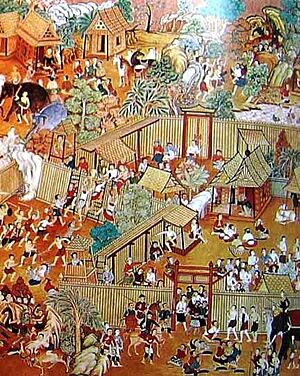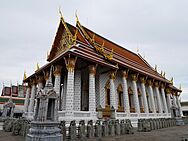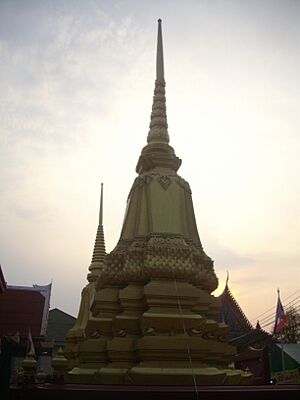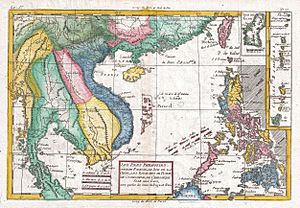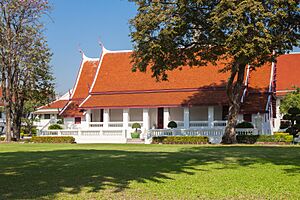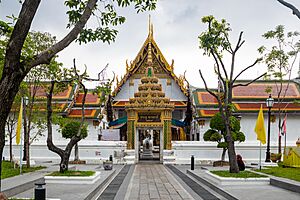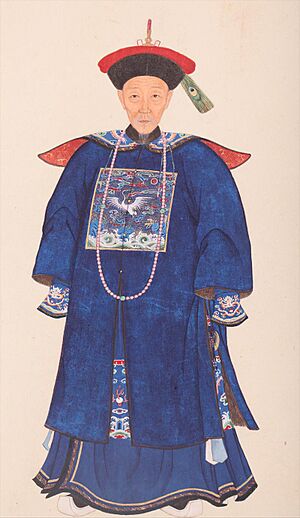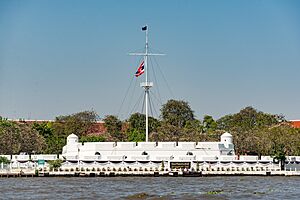Thonburi Kingdom facts for kids
Quick facts for kids
Thonburi Kingdom
อาณาจักรธนบุรี
Anachak Thonburi |
|||||||||||||||||
|---|---|---|---|---|---|---|---|---|---|---|---|---|---|---|---|---|---|
| 1767–1782 | |||||||||||||||||
|
Trade flag
|
|||||||||||||||||
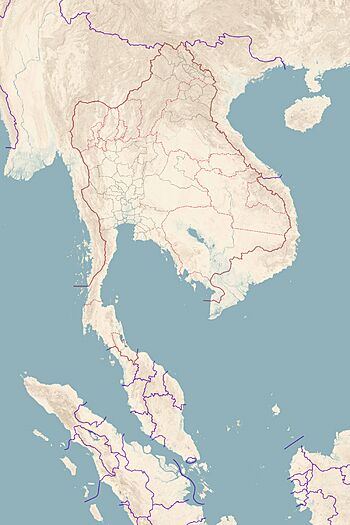
Sphere of influence of the Thonburi Kingdom in 1780; early modern Southeast Asian political borders are subject to speculation
|
|||||||||||||||||
| Capital | Thonburi | ||||||||||||||||
| Common languages |
|
||||||||||||||||
| Religion |
|
||||||||||||||||
| Government | Mandala kingship | ||||||||||||||||
| Monarch | |||||||||||||||||
|
• 1767–1782
|
Taksin | ||||||||||||||||
| Viceroy | |||||||||||||||||
|
• –1782
|
Inthraphithak | ||||||||||||||||
| Historical era | Early modern era | ||||||||||||||||
|
• Capture of Chonburi and Rayong
|
January 1767 | ||||||||||||||||
|
• Coronation of Taksin
|
28 December 1767 | ||||||||||||||||
|
• Capture of Nakhon Si Thammarat
|
21 September 1769 | ||||||||||||||||
|
• Capture of Phitsanulok
|
8 August 1770 | ||||||||||||||||
|
• Capture of Chiang Mai
|
14 January 1775 | ||||||||||||||||
|
• Fall of Phitsanulok
|
15 March 1776 | ||||||||||||||||
|
• Capture of Vientiane
|
March 1779 | ||||||||||||||||
|
• Recognition by the Qing dynasty
|
1781/1782 | ||||||||||||||||
|
• Deposition of Taksin
|
1 April 1782 | ||||||||||||||||
| Currency | Photduang | ||||||||||||||||
|
|||||||||||||||||
| Today part of | |||||||||||||||||
The Thonburi Kingdom (Thai: ธนบุรี, IAST: Dhanapura, pronounced [tʰōn būrīː]) was an important Siamese kingdom in Southeast Asia. It existed from 1767 to 1782. Its main city was Thonburi, which is part of modern-day Thailand.
The kingdom was started by King Taksin the Great. He brought Siam back together after the Ayutthaya Kingdom fell. After Ayutthaya's fall, Siam split into five smaller states that fought each other. The Thonburi Kingdom quickly reunited Siam. It became a strong military power in Southeast Asia. Siam grew to its largest size ever during this time. It included areas like Lan Na, the Laotian kingdoms, and Cambodia. These areas came under Siam's influence.
The Thonburi Kingdom also saw more trade with Qing China. This continued from the earlier Ayutthaya period. The Chinese community in Siam became more influential. King Taksin and later leaders had close ties with Sino-Siamese families.
The Thonburi Kingdom lasted only 14 years. It ended in 1782 when King Taksin was removed from power. A top military leader, Chao Phraya Chakri, took over. He then started the Rattanakosin Kingdom (1782–1932). This is the fourth and current ruling kingdom of Thailand.
Contents
History of the Thonburi Kingdom
How Taksin Reunited Siam
Phraya Tak, whose personal name was Sin, was a nobleman. He had Teochew Chinese family roots. During the Burmese–Siamese War (1765–1767), he was the governor of Tak. He was called to help defend Ayutthaya. In January 1767, about three months before Ayutthaya fell, Phraya Tak gathered 500 followers. He broke through the Burmese forces to the east.
After fighting some Burmese and local groups, Phraya Tak and his men settled in Rayong. This was on the eastern Siamese coast. There, Phraya Tak competed with Pu Lan, the governor of Chanthaburi. He wanted to control the eastern coastline. In a famous story, Phraya Tak ordered all cooking pots destroyed. This made his soldiers fight harder. He successfully took Chanthaburi in June 1767. Phraya Tak then controlled the eastern coast from Bang Plasoi (Chonburi) to Trat.
Ayutthaya fell in April 1767. Burma had to send most of its soldiers to fight China. So, the Burmese left only a small group at Phosamton. This group was led by the Mon commander Thugyi. The Burmese only controlled central Siam. The rest of Siam was taken over by different warlords.
- In the northeast, Prince Kromma Muen Thepphipit ruled from Phimai.
- In the north, Chaophraya Phitsanulok Rueang was based in Phitsanulok.
- A monk named Chao Phra Fang started a religious government in Sawangkhaburi.
- In the south, Phra Palat Nu led the Nakhon Si Thammarat (Ligor) area.
In October 1767, Phraya Tak left Chanthaburi. He took his fleet of 5,000 men to the Chao Phraya River. He captured Thonburi. Then, in November, he attacked the Burmese at Phosamton. He defeated the Burmese commander, Thugyi. Phraya Tak made Thonburi the new capital of Siam. He became king there in December 1767. People later called him King Taksin. He chose Thonburi as the capital because it was good for trade. It was also easier to defend than Ayutthaya.
Six months after Ayutthaya fell, Taksin had control of Central Siam. A Burmese force from Tavoy attacked a Chinese camp. This was at Bangkung in Samut Songkhram. King Taksin drove them back in the Battle of Bangkung in 1768.
King Taksin then fought against other leaders to unite Siam. He first attacked Phitsanulok in the north in 1768. But he was defeated at Koeichai. Taksin himself was shot in the leg. Thonburi then conquered the Phimai region in the northeast in 1768. They also took the Nakhon Si Thammarat region in October 1769. Prince Thepphiphit was executed. But Nakhon Nu of Ligor was allowed to live in custody.
In the north, Chao Phra Fang took over the Phitsanulok region in 1768. He became a strong enemy of Taksin. In 1770, Chao Phra Fang's forces reached as far south as Chainat. King Taksin fought back. He led the Thonburi armies to capture Phitsanulok in August 1770. Thonburi forces continued north to take Sawangkhaburi. Chao Phra Fang escaped and was never seen again. By 1770, Taksin had conquered all rival regions. His position as ruler of Siam was secure, and Siam was finally united.
Battles in Cambodia and Hà Tiên
In the 1700s, the port city of Hà Tiên became a major trade center. It was ruled by the Cantonese leader Mạc Thiên Tứ. After Ayutthaya fell, two Ayutthayan princes sought safety. Prince Chao Sisang went to Oudong in Cambodia. Prince Chao Chui went to Hà Tiên.
The Qing Chinese court in Beijing did not recognize King Taksin. This was because Mạc Thiên Tứ told Beijing that Ayutthayan royal family members were with him. In 1769, King Taksin asked King Ang Ton of Cambodia to pay tribute to Siam. Ang Ton refused. Taksin sent armies to invade Cambodia in 1769, but they were not successful.
In 1771, Taksin tried again to invade Cambodia and Hà Tiên. He wanted to find the Ayutthayan princes. He also wanted to put the pro-Siamese Ang Non on the Cambodian throne. King Taksin ordered Phraya Yommaraj Thongduang to lead 10,000 men by land. King Taksin himself, with Phraya Phiphit Chen Lian, led 15,000 men by sea. Hà Tiên fell to the Siamese in November 1771. Phraya Yommaraj also took control of Oudong and Cambodia.
Both Mạc Thiên Tứ and King Ang Ton fled to Cochinchina. They were protected by the Nguyen Lord. Taksin made Chen Lian the new governor of Hà Tiên. The Siamese armies continued looking for Mạc Thiên Tứ and Ang Ton. But Vietnamese forces defeated them at Châu Đốc. Taksin put Ang Non in charge of Cambodia. He returned to Thonburi in December 1771. He left Chen Lian in Hà Tiên and Phraya Yommaraj in Cambodia.
Prince Chui was captured and executed in Thonburi. Prince Sisang died in 1772. The Nguyen Lord Nguyễn Phúc Thuần launched counter-attacks. He wanted to restore Mạc Thiên Tứ and Ang Ton. Chen Lian, the Siamese governor of Hà Tiên, was defeated. He left Hà Tiên for three days. Then he gathered a fleet and retook the city. The Vietnamese commander Nguyễn Cửu Đàm took control of Phnom Penh and Cambodia in July 1772. Ang Non moved to Kampot.
However, this war happened at the same time as the Tây Sơn uprising. This uprising began in 1771 against the Nguyen Lord. Problems at home made the Nguyen Lord tell Mạc Thiên Tứ to make peace with Siam in 1773. Taksin realized Siam could not hold Cambodia and Hà Tiên. He ordered Siamese troops to leave Cambodia and Hà Tiên in 1773. But not before 10,000 Cambodians were taken to Siam as captives.
Ang Ton returned to rule Cambodia. But Vietnamese support decreased due to the Tây Sơn uprising. So, Ang Ton decided to make peace with Ang Non and Siam. Ang Ton gave up his throne in 1775 to Ang Non. Ang Non became the new pro-Siamese King of Cambodia. With the Ayutthayan princes gone, the Qing court's view of Taksin improved. The Qing finally recognized Taksin as Wang (King) of Siam in 1777.
Taking Control of Lanna
After Burma took over Lan Na (modern Northern Thailand) in 1763, it remained under Burmese rule. Thado Mindin, the Burmese governor of Chiang Mai, treated the local Lanna nobles badly. King Taksin marched against Chiang Mai in 1771 but could not capture the city. In Chiang Mai, Thado Mindin faced opposition from Phaya Chaban Boonma. He was a local Lanna noble who fought against Burmese rule.
In 1772, King Hsinbyushin of the Burmese Konbaung dynasty saw that Siam was strong again. Hsinbyushin started a new campaign against Siam. He ordered troops to gather in Chiang Mai and Martaban. He planned to invade Siam from both the north and the west. This was similar to the 1765-1767 invasion. In 1774, Binnya Sein led a failed Mon rebellion against Burma. This caused thousands of Mon people to flee to Siam. Hsinbyushin appointed Maha Thiha Thura, a famous general, as the supreme commander. He put Nemyo Thihapate, who conquered Ayutthaya in 1767, in charge of Burmese forces in Lanna.
Burmese forces from Chiang Mai attacked northern Siamese towns. They attacked Sawankhalok in 1771 and Phichai in 1772-1773. Taksin decided to end the Burmese threat from the north. He led an expedition to capture Chiang Mai in December 1774. This coincided with the Mon refugees arriving. Phaya Chaban of Chiang Mai learned of the Siamese invasion. He joined with Kawila of Lampang to overthrow the Burmese. Phaya Chaban secretly submitted to Taksin.
King Taksin marched to Tak. There he met the Mon refugees. Taksin ordered Chaophraya Chakri to lead the first group to Lampang. Kawila had already rebelled against the Burmese there. Kawila guided the Siamese armies to Chiang Mai. The brothers Chaophraya Chakri and Surasi joined forces. They successfully captured Chiang Mai in January 1775. Burmese leaders Thado Mindin and Nemyo Thihapate retreated to Chiang Saen. They set up a new Burmese headquarters there. This marked the shift of Lanna from Burmese to Siamese control after 200 years. However, northern parts of Lanna, like Chiang Saen, stayed under Burmese rule until 1804.
Phaya Chaban became the governor of Chiang Mai. Kawila became the governor of Lampang. In 1777, the Burmese attacked Chiang Mai to reclaim Lanna. Phaya Chaban decided to leave Chiang Mai because his forces were too small. Chiang Mai was then abandoned for twenty years. It was restored in 1797. Lampang, under Kawila, became the main defense against future Burmese attacks.
Burmese Attacks on Siam
King Hsinbyushin's plan to invade Siam from two directions failed. This was due to the Mon Rebellion and Siam taking Chiang Mai. Maha Thiha Thura, in Martaban, sent his lead force. It was led by Satpagyon Bo. They invaded Western Siam through the Three Pagodas Pass in February 1775. Taksin was not ready. Most of his troops were in the north defending Chiang Mai. He called the northern Siamese troops back to defend the west.
Satpagyon Bo took Kanchanaburi. He continued to Ratchaburi. There, he camped at Bangkaeo. This is why it's called the Bangkaeo Campaign. King Taksin sent early forces under his son and nephew. They were to fight the Burmese at Ratchaburi. The princes surrounded Satpagyon Bo at Bangkaeo. They wanted to starve the Burmese into surrendering. Northern Siamese troops arrived. This brought the total Siamese forces to 20,000 men. They greatly outnumbered the Burmese. After 47 days of being surrounded, Satpagyon Bo surrendered in March 1775. The Siamese took about 2,000 Burmese captives.
Six months after the Siamese victory, in September 1775, the Burmese attacked Chiang Mai again. Chaophrayas Chakri and Surasi led troops north to defend Chiang Mai. However, Maha Thiha Thura used this chance. He personally led 35,000 Burmese men. They came through the Mae Lamao Pass. They invaded Northern Siam in October. Chakri and Surasi had to rush back to defend Phitsanulok. Maha Thiha Thura besieged Phitsanulok. This was the main city of Northern Siam.
King Taksin led the royal armies from Thonburi to the north. He stayed at Pakphing near Phitsanulok. He tried to end the siege. Maha Thiha Thura attacked the Siamese supply line. This was at Nakhon Sawan and Uthaithani. He also defeated King Taksin in the Battle of Pakphing in March 1776. This forced the Siamese king to retreat south to Phichit. Chaophrayas Chakri and Surasi then decided to leave Phitsanulok. Phitsanulok fell to the Burmese. It was completely destroyed and burned down.
Maha Thiha Thura was preparing to march on Thonburi. But he learned that Burmese King Hsinbyushin had died in 1776. Maha Thiha Thura was called back. He suddenly left the campaign in Siam. He quickly returned to Burma to support his son-in-law Singu Min for the throne. The remaining Burmese soldiers in Siam were left without orders. Siam almost fell to Burmese conquest a second time. The death of Hsinbyushin saved Siam. King Taksin took this chance to chase the retreating Burmese. All Burmese had left Siam by August 1776, and the war ended.
Conquering Laos
In 1765, the Lao kingdoms of Luang Phrabang and Vientiane became Burmese vassals. After Siam captured Chiang Mai in 1775, Burma's power in Laos weakened. King Ong Boun of Vientiane had been a Burmese ally. He had encouraged the Burmese to invade his rival, Luang Phrabang, twice. King Taksin suspected Ong Boun was working with Burma.
In 1777, the governor of Nangrong rebelled against Thonburi. He had support from Champasak. King Taksin ordered Chaophraya Chakri to lead Siamese armies to invade Champasak. After this, Taksin gave Chakri the high title of Somdet Chaophraya Maha Kasatsuk. This was the highest rank a noble could get, equal to a prince.
In 1778, Phra Vo, a Lao leader, sought protection from Siam against Ong Boun. However, Ong Boun sent troops to defeat and kill Phra Vo that same year. This angered Taksin, who saw Phra Vo as his subject. Phra Vo's death was the reason for Thonburi to conquer the Lao kingdoms in 1778. Taksin ordered Chaophraya Chakri to invade Laos. Chaophraya Chakri told his brother Chaophraya Surasi to go to Cambodia. Surasi was to raise troops there and invade Laos from another direction.
Surasi led his Cambodian army. He crossed the Liphi waterfall and captured Champasak. King Sayakumane of Champasak was taken to Thonburi. Chakri and Surasi then met at Vientiane. King Surinyavong of Luang Phrabang had long disliked Ong Boun. He joined the Siamese side and sent forces. King Ong Boun put his son Nanthasen in charge of defending Vientiane. Nanthasen resisted the Siamese for four months. But the situation became very bad. Ong Boun secretly escaped Vientiane. He left his son Nanthasen to surrender and open the city gates to the Siamese in 1779.
Two important Buddha images, the Emerald Buddha and Phra Bang, were taken. These were symbols of the Vientiane kingdom. The victorious Siamese took them to Thonburi. They were placed at Wat Arun. Lao people from Vientiane, including royals like Nanthasen and the future king Anouvong, were moved. They were settled in Thonburi and other places in Central Siam. All three Lao kingdoms—Luang Phrabang, Vientiane, and Champasak—became tributary kingdoms of Siam.
The End of the Thonburi Kingdom
King Taksin's way of ruling was different from the old Ayutthaya kings. He focused on his own strength and achievements. At first, his energy in fighting the Burmese earned him loyalty. But over time, some people noticed his rule was unusual. He did not build a grand royal city or splendid palaces. He also did not follow the old Ayutthayan traditions. High titles and commands went to his early followers. Many of these were not from the highest noble families.
Taksin's defeat by the Burmese in 1776 affected him greatly. After 1776, Taksin stopped leading armies himself. He gave military commands to the brothers Chaophraya Chakri and Chaophraya Surasi. This shifted power away from him. He began to focus more on religious practices. Chaophraya Chakri became the most powerful court official. He represented the old Ayutthayan noble families.
King Taksin had problems with French missionaries in 1775. They refused to join a ceremony. He eventually sent them out of Siam in 1779. A decade of constant warfare had worn him down. In late 1776, Taksin became very interested in Buddhist meditation. In 1777, he told a group of monks that he had become a Buddhist saint. He even believed he could fly.
In 1779, King Ang Non of Cambodia, Taksin's ally, was killed. A pro-Vietnamese Cambodian minister took power. Taksin's relationship with his son Prince Inthraphithak worsened. He even sent his son away from the palace. His strange behavior and religious focus grew worse in mid-1780. He ordered Buddhist monks to bow to him, which was against tradition. Five hundred monks who refused were punished. In 1780, Taksin ordered the killing of about fifty Vietnamese people. This included Mạc Thiên Tứ, who had sought safety in Thonburi. They were accused of plotting against him.
In May 1781, Taksin sent his first official mission to China. In December 1781, King Taksin sent 20,000 men to Cambodia. They were led by Chaophrayas Chakri and Surasi. Their goal was to restore Siamese influence and make his son Inthraphithak the new King of Cambodia. Taksin also punished many people unfairly. He suspected a court lady of stealing and had her burned. He falsely punished about three hundred people for smuggling rice and salt. Chinese merchants faced difficulties, and some were killed.
In March 1782, a rebellion started in Ayutthaya. It was about rights to dig for old treasures. King Taksin sent Phraya San to stop it. But Phraya San joined the rebels instead. He returned to attack Thonburi. Most of Taksin's troops were in Cambodia. Taksin relied on Portuguese soldiers to defend him. But they soon left him. Taksin surrendered. Phraya San forced Taksin to give up his throne. Taksin became a monk at Wat Arun. Phraya San took control in Thonburi.
Chaophraya Chakri in Cambodia heard about these events. He sent his nephew Phra Suriya Aphai to lead armies from Nakhon Ratchasima. They were to bring peace to Thonburi. Phraya San ordered Taksin's nephew, Prince Anurak Songkhram, to attack Phra Suriya Aphai. This happened at Bangkok Noi in April 1782. Phra Suriya Aphai was almost defeated. But Siri Rochana, Surasi's wife, asked a Mon leader to attack Prince Anurak Songkhram from behind. This allowed Phra Suriya Aphai to win. Phraya San's army retreated.
Chaophraya Chakri made a peace deal with the Vietnamese. He then returned to Thonburi. He held a court to judge Taksin and Phraya San. Taksin was removed from power for his "improper and unjust actions." Phraya San, his supporters, and others loyal to Thonburi were also removed. Taksin's son Inthraphithak and nephews were also removed. But his other young children were allowed to live. Chaophraya Chakri became King Rama I. He started the new Chakri dynasty of the Rattanakosin Kingdom in April 1782.
How the Thonburi Government Worked
The Thonburi government was like a group of city-states. Local lords ruled these areas. They were connected to the king through personal relationships. This was similar to how Ayutthaya and later Rattanakosin worked. Thonburi used most of the same government system as late Ayutthaya.
Two main ministers led the central government:
- Samuha Nayok was the Prime Minister.
- Samuha Kalahom was the Minister of Military.
In the early years, Chaophraya Chakri Mud, a Muslim of Persian background, was the Samuha Nayok. He held this position until he died in 1774. Chaophraya Chakri Thongduang, who later became King Rama I, took over as Prime Minister. Below these two were the four ministers of Chatusadom.
Like in Ayutthaya, the regional government had a system of cities. Smaller towns were under the control of larger cities. The provincial government was a group of local lords. They were connected to the king. Phitsanulok was the main city for Northern Siam. Nakhon Si Thammarat was the center for Southern Siam.
After conquering Northern Siam in 1770, King Taksin appointed his early supporters as governors. These were people who had fought well in battles. Governors of Sawankhalok, Nakhon Sawan, and Sankhaburi received very high ranks. The central ministers had lower ranks. Chaophraya Surasi Boonma was the governor of Phitsanulok. Phitsanulok and other northern towns were badly damaged by Maha Thiha Thura's invasion in 1775–1776.
After conquering Ligor in 1769, Taksin made his nephew, Prince Nara Suriyawong, the ruler of Nakhon Si Thammarat. Prince Nara Suriyawong died in 1776. King Taksin then made Chaophraya Nakhon Nu the autonomous ruler of Nakhon Si Thammarat. He was the former leader of the Ligor region. Ligor remained somewhat independent until 1782. When King Rama I took power, he reduced Ligor's power. Its ruler became a 'governor' instead.
Most high political positions in Thonburi went to Taksin's early followers. This was different from the established Siamese nobility. Many nobles had supported Thep Phiphit during the civil war. Bunma (later Chao Phraya Surasi) and his brother Thongduang (later Chao Phraya Chakri) were exceptions. They were from the old Ayutthaya nobility but joined Taksin early. In the Northern cities, Taksin installed his supporters. Many were allowed to start their own local ruling families. But in other places, noble families kept their titles. Their personal connections made them powerful in the Thonburi court.
The King's Role
The Thonburi period saw a return to 'personal kingship'. This was a style of rule used by King Naresuan centuries before. Taksin, like Naresuan, often led his armies into battle himself. He also showed himself to common people. He took part in public events and festivals. This was different from many Ayutthaya kings who kept a sense of mystery.
Taksin was also known for being a strict ruler. He ruled simply. He did not try to make his new capital look like Ayutthaya. He used an existing temple, Wat Jaeng (later Wat Arun), as the main temple. Taksin focused on building moats and defensive walls in Thonburi. He only built a modest Chinese-style home. He added a small building at Wat Jaeng to house the Emerald Buddha and Phra Bang images. These were taken from Laos in 1778.
Kingdom's Territories
After Ayutthaya fell in 1767, Siam's old system of influence broke down. Its former tributary states faced uncertainty. The Malay sultanates, who used to send tributes to Ayutthaya, stopped doing so. After Thonburi was established, the sultanates of Pattani, Terengganu, and possibly Kedah sent tributes to Thonburi in 1769. Francis Light mentioned that Kedah sent tributes to Siam, but he did not say when.
Even with tributes, Siam's control over the Malay sultanates was unclear. King Taksin asked Pattani, Kelantan, and Terengganu for military and money help. This was to fight the Burmese invasion in 1776. However, the Malay sultans ignored this order. They faced no punishment. In 1777, Nakhon Nu, the ruler of Ligor, suggested invading the Malay sultanates. King Taksin refused. He said defending against Burmese attacks was more important. Siam only regained real control over the Northern Malay sultanates in 1786. This was during the Rattanakosin Period.
The Thonburi Kingdom took back most of the land that Ayutthaya once held. It expanded Siam to its largest size up to that point. This was except for the western Tenasserim Coast. During the Thonburi period, Siam gained new tributary kingdoms. Thonburi took control of Lanna in 1775. This ended 200 years of Burmese rule. Lanna is now Northern Thailand. Taksin appointed his supporters, Phaya Chaban and Kawila, as governors. They ruled Chiang Mai and Lampang in 1775. The princedom of Nan also came under Thonburi's power in 1775.
However, Burma tried hard to reclaim Lanna. This led to Chiang Mai being abandoned in 1777. Nan was also abandoned in 1775 due to Burmese threats. Only Lampang, under Kawila, stood as the main defense against Burmese attacks.
After capturing Vientiane in 1779, all three Lao kingdoms became tributary kingdoms. These were Luang Phrabang, Vientiane, and Champasak. King Taksin appointed the Lao prince Nanthasen as the new King of Vientiane in 1781. At its peak in 1782, the Thonburi Kingdom had several vassal states. These included the Nakhon Si Thammarat Kingdom. Also, the Northern Thai areas of Chiang Mai, Lampang, Nan, Lamphun, and Phrae. And the Lao Kingdoms of Champasak, Luang Phrabang, and Vientiane. They all had different levels of independence.
Economy of Thonburi
| Year | Price |
|---|---|
| 1758
(Ayutthaya) |
12 Tamlueng
(720 g of silver) |
| 1769
(Thonburi) |
2 Chang
(2,400 g of silver) |
| 1770
(Thonburi) |
3 Chang
(3,600 g of silver) |
| 1775
(Thonburi) |
10 Tamlueng
(600 g of silver) |
| 1785
(Rattanakosin) |
1 Chang
(1,200 g of silver) |
| 1821
(Rattanakosin) |
7 Tamlueng
(420 g of silver) |
In the late Ayutthaya Period, Siam sold a lot of rice to Qing China. After Ayutthaya fell in 1767, Siam's economy collapsed. Rice production and other economic activities stopped. The Thonburi period was a time of economic crisis. Many people died from war and hunger. Prices for goods were very high. Siam had to import rice.
In 1767, after taking back Ayutthaya, King Taksin helped over 1,000 poor people. He even ordered an old bronze cannon to be melted down. The metal was sold to buy rice for starving people. This made him very popular. The price of rice was very high in Thonburi. In 1770, it reached its highest price. The Thonburi court bought imported rice to help with the famine. Hà Tiên was a major rice exporter to Siam before 1771.
Qing China and the Dutch were Siam's main trading partners. The Ayutthayan court relied on trade with China for money. The Dutch had left their trading post in Ayutthaya in 1765 because of the Burmese invasion. The Thonburi court sent a letter to the Dutch East India Company in 1769. They wanted to restart trade. But the Dutch were not interested.
King Taksin, who was Teochew Chinese, wanted China to recognize him. But the Qing court refused. Mạc Thiên Tứ of Hà Tiên had told Beijing that Ayutthaya's royal family members were with him. This made Taksin invade Hà Tiên in 1771. He wanted to destroy Hà Tiên and capture the old royal family members. Only then did the Qing finally recognize Taksin as King of Siam in 1777.
Even though Siam did not have good relations with China until 1777, private trade grew. A Chinese document from 1776 showed that trade between China and Siam quickly recovered. King Taksin used his own Chinese merchants to trade at Guangzhou. This brought money into the royal treasury. J. G. Koenig, a Danish botanist, visited Siam in 1779. He noted that Siam had many goods from China. He also said King Taksin made a lot of money. He bought goods cheaply and sold them for a 100 percent profit.
In the early years of Thonburi, a Teochew Chinese man named Phraya Phiphit Chen Lian was the acting Minister of Trade. Chen Lian became governor of Hà Tiên in 1771. Another Chinese man, Phraya Phichai Aisawan Yang Jinzong, took over as Minister of Trade.
Siam's economy improved as trade and production restarted. But after the Burmese invasion of 1775–1776, Central Siam was devastated. The economy went down again. King Taksin ordered his ministers to oversee rice production. He also had to delay sending a tribute mission to China. During the Burmese invasion of Ayutthaya, rich people buried their wealth. Many died or were taken to Burma. So, they could not claim their treasures. Surviving owners and others rushed to dig for treasures. This treasure hunt was so widespread that the Thonburi court started taxing it.
Population Changes
Before Ayutthaya fell in 1767, Siam's population was about two million. About 200,000 people lived in Ayutthaya city. It is thought that 30,000 people from Ayutthaya were taken to Burma. There are no exact records of population changes after 1767. But it is clear that many Siamese people died in the war. The overall population dropped sharply. Central Siam was the most affected area because it was where most of the fighting happened. Many people also escaped the chaos by living in jungles. The lack of people caused economic and military problems for Siam. In 1782, the new city of Bangkok had about 50,000 people. This was probably similar to Thonburi's population at the end of the period.
Controlling manpower had been a problem since the late Ayutthaya Period. It was one reason Ayutthaya fell. In 1773, King Taksin introduced Conscription Tattooing. This was not widely used before. It helped to control manpower strictly. Healthy male commoners of a certain age were drafted. They were marked on their wrists with small tattoos. These showed their assigned departments. This was a form of universal conscription. The Conscription Department registered recruits. This tattooing made recruitment more effective. It also made it harder to avoid service. This practice continued into the Rattanakosin Period. Commoners had heavy labor duties in Thonburi. This was because there was a lack of manpower. In Ayutthaya and Rattanakosin, commoners served in alternating months. They had free time to go home. But in Thonburi, they served the government all year.
The Thonburi Kingdom also gained people through forced migration. This happened during military conquests. Two major population movements occurred. In 1773, 10,000 Cambodians were moved to Siam. In 1779, tens of thousands of Lao people were moved. These groups were settled in various towns in Central Siam. This was where more workers were needed. Cambodians settled in Thonburi and Ratchaburi. Lao people went to Saraburi, Thonburi, and Ratchaburi. People from as far as the Tai Dam of Sipsong Chuthai were taken to Phetchaburi. Cambodian and Lao people became a major workforce for building Bangkok in 1782. A failed Mon rebellion against Burma in 1774 also led to thousands of Mon people fleeing to Siam. King Taksin also encouraged his fellow Teochew Chinese people to move from Guangdong. He did this to help with the shortage of workers.
Unlike Central Siam, Northern Siam was mostly spared from Burmese destruction in 1767. This area included the old Sukhothai Kingdom lands. However, the Burmese invasion by Maha Thiha Thura in 1775–1776 devastated Northern Siam. Thai records say that before 1775, Phitsanulok had 15,000 men. Sawankhalok had 7,000 men, and Sukhothai had 5,000 men. A decade later, during the Nine Armies' War in 1786, Northern Siam had so few people. It could not raise an army to defend itself. In 1833, only 5,000 men from Phitsanulok, 500 from Sawankhalok, and 600 from Sukhothai were drafted. This shows a big drop in population.
Religion in Thonburi
Theravada Buddhism
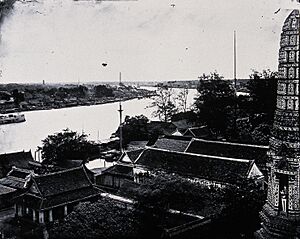
After Ayutthaya fell, the Buddhist monk community broke apart. Monks were left without support. King Taksin worked to rebuild Theravada Buddhism in Siam. Taksin ordered his officials to find wise monks. He gave them new robes and honors. He invited them to live in Thonburi. In 1768, King Taksin gathered monks at Wat Bangwayai temple (now Wat Rakhang). Taksin set up a new system for monks. He appointed a respected monk named Dee as the Sangharaja (Buddhist leader) in 1769.
However, the Sangharaja Dee was accused of working with Burmese occupiers. He was said to have taken money from people. He was put on trial. He failed a test to prove his innocence. He was removed from his position and no longer a monk.
When King Taksin captured Nakhon Si Thammarat (Ligor) in 1769, he gave money, rice, and robes to the monks there. He also had Pāli Tripitaka manuscripts brought from Ligor to Thonburi. This was to make copies of Buddhist scriptures lost in the wars. King Taksin appointed the respected monk Si from Wat Phanan Choeng as the new Sangharaja in 1770. He stayed at Wat Bangwayai in Thonburi.
King Taksin treated Southern Siamese monks well. But he was different with Northern Siamese monks. Taksin believed Northern monks followed Chao Phra Fang. Chao Phra Fang was a rival warlord who claimed special powers. After conquering Northern Siam in 1770, King Taksin ordered many Northern monks to leave their monkhood. Those who wanted to stay monks had to pass a test. They had to dive into water to prove their holiness. King Taksin led a big ceremony to purify the Northern monk community. Monks were put through these tests. This was likely to remove any supporters of Chao Phra Fang. Then, King Taksin appointed Central Siamese monks from Thonburi to lead temples in Northern Siam.
King Taksin wanted not only to be king but also to achieve Buddhahood. He believed meditation was the way. In late 1776, King Taksin actively practiced special Buddhist meditations. He studied meditation methods with the monk Phra Wannarat Thongyu. King Taksin even wrote his own meditation guide in 1775. He sent monks to Ligor and Cambodia to find a book on meditation. In 1777, King Taksin declared he had reached the first stage of Buddhahood. In 1778, Taksin ordered a new version of Traiphum, a Buddhist book on the universe.
Upholding Buddhism was a royal duty. But Taksin went further. He took on the role of teacher and leader of the monks. He personally practiced meditation. In 1780, King Taksin ordered monks to bow to him. This was a reversal of the usual respect given to monks. This caused a split among the monks. Some followed the king, others refused. Sangharaja Si insisted that monks were always superior to laypeople. The king was angry. He removed Venerable Si from his position. He made the monk Chuen, who supported Taksin, the new Sangharaja. Five hundred monks who refused to obey were beaten. Si and other monks were forced to do menial work. When Taksin lost power in 1782, King Rama I restored Venerable Si to his position. He praised him for sticking to traditional beliefs.
Christianity in Thonburi
Pierre Brigot, a Catholic leader in Ayutthaya, was captured by the Burmese in 1767. He was taken to Rangoon in Burma. Brigot later went to Pondicherry in 1768 and never returned to Siam. Father Jacques Corre, a French priest, led about 400-500 Portuguese Christians. They moved from Ayutthaya to the Kudi Chin area in Thonburi. Olivier-Simon Le Bon, a French bishop, arrived in Thonburi in 1772. He wanted to restart Christian missions in Siam. In 1772, some Christians who did not accept the French mission moved. They founded the Holy Rosary Church on the east bank.
In 1775, King Taksin invited Buddhist monks, Christian priests, and Muslims to a debate. They discussed if killing animals was a sin. Christians and Muslims argued it was not sinful. Taksin was angered by this. In March 1775, he issued a rule. It forbade Siamese and Mon people from converting to Christianity and Islam. The king became suspicious of the Christian missionaries.
Taksin ordered the missionaries to take a Siamese oath of loyalty. They had to drink special water. The missionaries found out they had to swear loyalty in front of a Buddha image. So, they refused. King Taksin was even more angry. He ordered Bishop Le Bon and two other French priests arrested in September 1775. They were put in neck restraints, questioned, and whipped. They were released a year later in September 1776. Olivier-Simon Le Bon was appointed the new Catholic leader in Siam soon after. However, conditions for Christian missionaries worsened. They were eventually expelled from Siam in December 1779. Le Bon retired to Goa and died in 1780. Joseph-Louis Coudé became the new Catholic leader in Siam in 1782. Coudé went to Bangkok in 1783. The new King Rama I pardoned him. He allowed the missionaries to skip the drinking ceremony.
Diplomacy and Foreign Relations
Relations with China
In September 1767, Li Shiyao, the Chinese viceroy, sent Xu Quan to investigate Siam. This was after Ayutthaya fell. As soon as King Taksin set up his capital in Thonburi, he sent his Chinese merchant Chen Mei to Guangzhou. This was in September 1768. Taksin, calling himself Gan En Zhi, told the Chinese court that Ayutthaya had fallen. He asked Emperor Qianlong to officially recognize him as 'King of Siam'. This recognition would help Taksin control other lords.
However, Mạc Thiên Tứ of Hà Tiên also sent a mission to Guangzhou in 1768. Mạc Thiên Tứ told the Chinese court that two Ayutthayan princes were with him. Emperor Qianlong strongly rejected Taksin's request. He told Taksin to put the Ayutthayan princes on the throne instead. Xu Quan died in August 1768. Li Shiyao sent Zheng Rui as a replacement in December 1768. In 1769, Zheng Rui met Prince Chui in Hà Tiên. Prince Chui told Zheng Rui he needed help from the Chinese Emperor.
The Thonburi court sent a letter to the Dutch East India Company in January 1769. They told the Dutch that the former Siamese king had sent Phraya Tak to Chanthaburi. Thonburi asked for thousands of flintlock bullets from the Dutch. They also asked the Dutch to send a letter to the Prince of Orange. They wanted the prince to appoint a new Dutch representative in Siam to restart trade. But the Dutch were not interested in returning to Siam. They had left their factory in Ayutthaya in 1765 because of the Burmese invasion. The Dutch replied in May 1769. They said restarting a Dutch factory needed the Prince of Orange's approval. But they promised to send the bullets through Chinese ships. The Dutch flintlock muskets arrived in Thonburi in 1770. The Dutch would not make any new agreements with Siam until 1860.
China and Burma were fighting the Sino–Burmese War. In August 1769, Li Shiyao sent a commander to Mạc Thiên Tứ. He ordered Mạc Thiên Tứ to capture the Burmese. But Mạc Thiên Tứ suggested the order go to King Taksin instead. The Chinese commander sent the order to Taksin. He urged Taksin to chase and capture the Burmese. The Qing court then realized King Taksin was the real ruler of Siam. They began to change their diplomatic approach. King Taksin used China's dislike of Burma to his advantage. In his second mission in August 1771, he sent fifty Burmese captives to Guangzhou. He called himself Zheng Zhao in the letter. Emperor Qianlong supported Taksin in November 1771. He realized the Siamese king could be a good ally against the Burmese. After capturing Hà Tiên in November 1771, Taksin sent the Chinese farmers there back to China unharmed. By 1772, it was clear Taksin had won over Mạc Thiên Tứ in diplomacy.
The Qing court made an exception. They allowed Thonburi to buy military supplies from China. These were usually forbidden for export. This was to help Siam fight the Burmese. King Taksin sent his Chinese merchants in 1774 and 1775. They bought gunpowder and other military equipment in Guangzhou. As things improved for him, Taksin sent a mission in July 1777. He told the new viceroy that he wanted to offer traditional tributes to the Chinese Emperor. The Emperor replied by keeping the door open for Taksin's rule. At this time, the Qing court called Taksin Wang or 'King' for the first time. This was an unofficial recognition of Taksin as King of Siam. However, Taksin showed little interest. He had already secured his power. He no longer needed Chinese influence to strengthen his position.
Because of the devastating Burmese invasion of 1775–1776, King Taksin sent a letter. He asked to delay the tribute mission in 1778. The first and only official Siamese tribute mission to China during the Thonburi Period was sent in May 1781. It was led by Phraya Sundhon Aphai. All the traditional ceremonies were followed for the first time since Ayutthaya fell. In February 1782, the Siamese mission reached Beijing. But Phraya Sundhon Aphai fell ill and died. The Qing court arranged his funeral. His deputy took over. The mission returned to Thonburi in July 1782. The Qing court finally recognized Taksin as King of Siam. They gave him red robes and a Qing royal stamp. However, when the mission returned, the government had changed. Taksin had been removed from power. The new Rattanakosin court was officially recognized by the Qing in 1787. This was during the reign of King Rama I.
Britain and Denmark
In 1776, Francis Light, a British merchant, bought 1,400 flintlock guns. He got them from the Danish in Tranquebar. He gave them to King Taksin as gifts. King Taksin wanted more flintlock muskets. So, he had his Minister of Trade write a letter to the Danish. In the letter from December 1776, Siam asked for 10,000 flintlock muskets. They offered Siamese tin in exchange.
Military Power
Like King Naresuan two centuries earlier, Taksin often led his troops in battles. Later, Taksin started to let his main generals lead more. These were Chao Phraya Chakri and Chao Phraya Surasi. For example, they led the 1781 expedition to Cambodia. This was just before Taksin was removed from power.
After the Burmese–Siamese War (1775–1776), the military power in the kingdom changed. Taksin took troops from his old followers in the Northern Cities. They had not performed well in the war. He gathered these forces to protect the capital at Thonburi. This was also similar to Naresuan's actions. He put more military power in the hands of two strong general brothers. These were Chao Phraya Chakri and Chao Phraya Surasi. They were from the traditional noble families. They later removed Taksin from power in 1782.
See also
- King Taksin the Great
- Coronation of the Thai monarch
- List of Thai monarchs
- Family tree of Thai monarchs
- Thonburi province
- Thon Buri (district)



